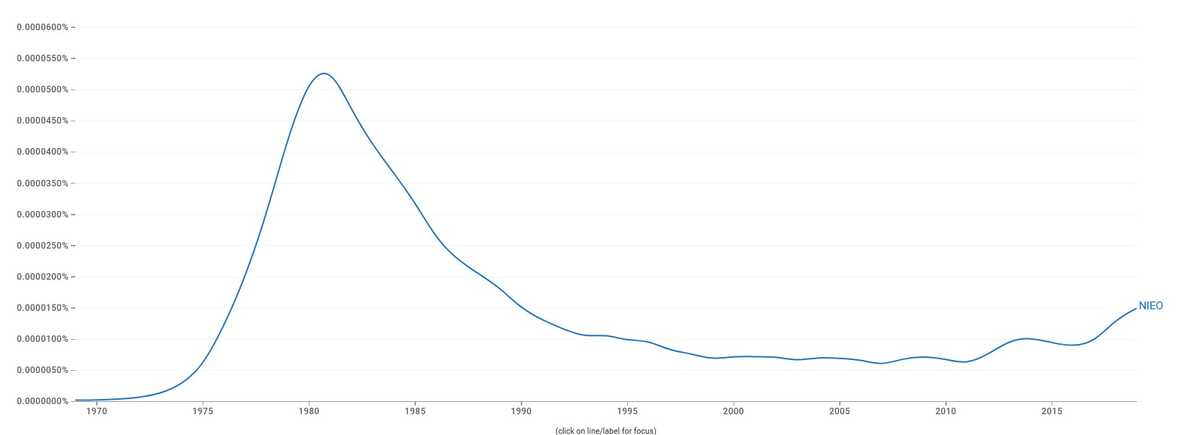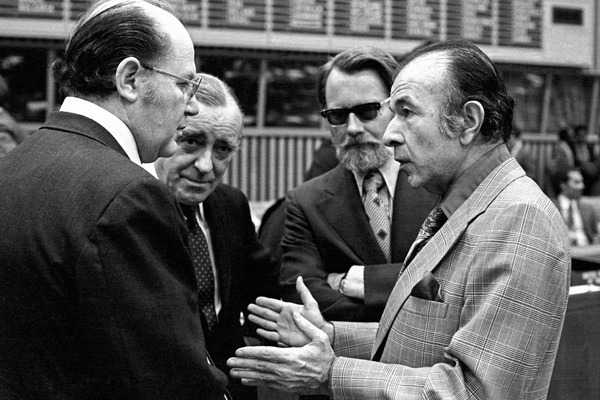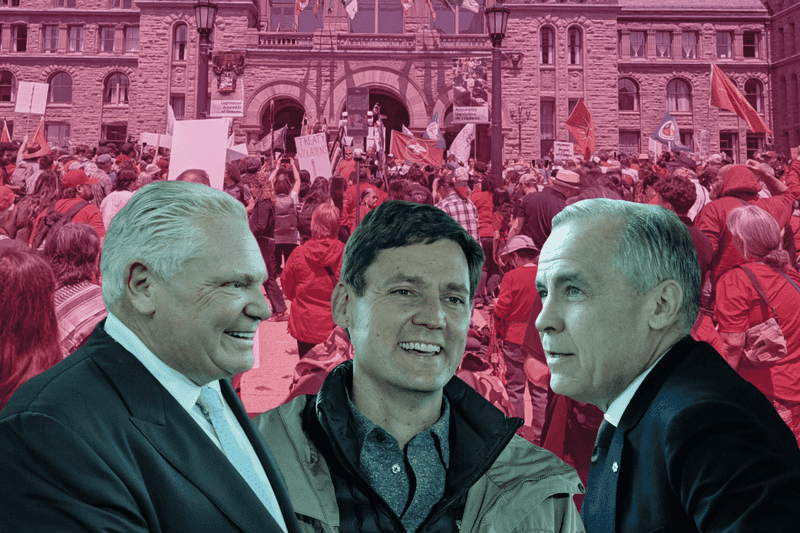"Look back at history and you will see appearing and vanishing... all manner of queer geniuses, wraith-like personalities that have left behind them sometimes a fragment or so that has meaning for us now.”
– Van Wyck Brooks, The Dial, 1918
The idea of a “New International Economic Order” was officially promulgated by the United Nations in a Declaration in May 1974. A cri de coeur issued by the countries of the Global South, led by the Group of 77, a coalition of recently postcolonial countries in Africa and Asia as well as most of the countries of Latin America, the NIEO called for a dramatic restructuring of the terms of trade and finance in favor of the poorer countries of the world, and a concomitant decentering of the global economic power structure away from the industrial core of the North Atlantic. Noting that de jure political decolonization had yet to be followed by effective economic independence and prosperity for postcolonial states, the proponents of the NIEO specifically called for a revisions to the rules of international trade, particularly with respect to agricultural goods and primary commodities; reforms to the Bretton Woods-based international monetary system in order to improve financing options for countries in the South; financial and technology transfers to promote the more rapid industrialization of the South; and new forms of cooperation among the countries of the South in order to replace the ongoing economic dependency on former metropolitan overlords.
While the NIEO was the subject of a great deal of international discussion over the course of the 1970s — and even some polite hearings in social democratic quarters of the Global North led by former German Chancellor Willy Brandt — by the early 1980s the initiative had ground to a halt as actual economic policy worldwide took a radically different direction. Instead of world-systemic reforms designed to improve the terms of trade between countries, what instead became the focal point of economic reform were so-called “structural adjustments” to countries within the Global South, in the form of conditional lending agreements issued by the World Bank and the IMF that enforced what would by the end of that decade become known as the “Washington Consensus” — including tax cuts for the rich, fiscal policy discipline, the reduction of both state industrial subsidies and barriers to foreign ownership, privatization of state-owned enterprises, deregulation of industries and in particular finance, as well as market-based exchange rates and the reduction of tariffs. This policy package was rooted in precisely the opposite assumption that had guided the NIEO: instead of seeing the poor or declining economic performance of countries in the Global South as being a result of an unfair global system, as the NIEO had asserted, the blame was assigned to the economic decisions of individual nation-states, whose internal policies needed to be reformed in order for these countries to have a chance to thrive in the competitive world of global capitalism. Instead of a socialism of nation-states, as the vision underpinning the NIEO was sometimes described, what the world instead experienced was the rollback of socialist principles in one country after another, culminating most dramatically in the collapse of Eastern European communism at the end of that decade.
By the early 1990s, when Francis Fukuyama declared that the contestation over the right form of political-economic organization had come to an end with a decisive victory for neoliberal capitalism, the proposals of the original NIEO were not just dead, they had been almost completely forgotten – at least in the corridors of political power and academic prestige in the Global North. Insofar as people in the Global North remembered and referenced the NIEO at all during the next two decades, it was mostly as an historical curiosity, a marker of the wrongheadedness of some of the ideas that some “unrealistic” souls had tried to promote during a time of international dislocation during the stagflationary 1970s – ideas whose non-implementation could be treated mainly with a sigh of relief: thank god we dodged that bullet.
Then came the Global Financial Crisis (GFC), which began in 2007-8. While global capitalism had experienced regular financial crises throughout its run from the early 1980s forward, notably the so-called “peso crisis” of 1985, the 1997 Asian financial crisis, and the Russian bond default in 1998 that led to the collapse of a major hedge fund, these previous episodes were treated in Washington, New York and London as confirming that the problems of global capitalism were symptoms of internal policy deficiencies in countries of the Global South, rather than as emblematic of a structural problem with neoliberal capitalism itself. In 2007-8, however, the call came from inside the house of global financial capitalism, with the crisis beginning in the United States’s own subprime mortgage market, and then quickly cascading outward to engulf not just the financial markets but soon the real economies of most of the Global North, which would soon thereafter ramify outward to every financial, trade, and commodity market with any exposure to global markets. In some initially inchoate but ultimately undeniable way, it was neoliberalism itself that was seen as the culprit for the crisis.
In retrospect, however, the defining feature of the GFC was not just that it cratered the ideological legitimacy of neoliberalism as a form of political economy, but also that nothing was done to reform the institutions of neoliberalism. Obama, infamously, came into office in the teeth of the financial crisis, but instead of imposing dramatic economic reforms, accepted a mid-level degree of fiscal stimulus. In Europe, the policy reaction was even worse, with austerity, rather than stimulus, forming the central prescription. The reason for these reactions was, in retrospect, quite evident: there were scarcely any dramatic policy alternatives available to act on. This intellectual gap was, in its own way, the greatest indicator of how thoroughgoing and secure the ideological victory of neoliberalism had been prior to 2007. When Margaret Thatcher had begun declaring “There Is No Alternative” to neoliberalism in the early 1980s, it had been widely contested, but by 2007 the victory of that perspective was almost complete. Indeed, German Chancellor Angela Merkel had made the point explicitly in reaction to critics of her government’s response to the European sovereign-debt crisis: she called the policies alternativlos, literally “alternative-less.”
But crises have a way of accelerating change. While the dominant policymakers of the time failed to pursue any novel reform options, the scale and scope of the crisis would lead to a dramatic new generation of economic thinking, ranging from calls for renewed industrial strategy to radically overhauled tax policies. New thinking also began to emerge on international trade, one of the effects of which was to revive interest in the lost history of the NIEO. Writing nearly a decade ago, at the start of this post-GFC revival of interest, I noted that “seemingly failed political and social movements, even though they did not realize their ambitions in their own moment, often live on as prophetic visions, available as an idiom for future generations to articulate their own hopes and dreams.” Fifty years from the original NIEO, this volume returns to its prophetic visions — and builds a program grounded in the hopes and dreams they have inspired.

Salvaging Alternative Futures
As historian Warren Sussman observed half a century ago, we turn to “the past in an effort to find a new ideological position that [we can] offer in refutation of accepted contemporary ideologies.” In this sense, finding a past precedent for contemporary political projects serves a tacit legitimating function: what a (putative) historical precedent suggests is, “Look: this isn’t crazy: People have been saying (or doing) this for years!” This idea of seeking out a “usable past” for contemporary political projects has a long legacy, across many time periods, geographies, and ideologies. Views of the past have consequences in the present, not because the past “determines” the present in some direct causal way, but because how we understand the past shapes the programs and actions we consider viable and appropriate in the present and future.
Marx himself recognized the point when he observed in his essay, “The 18th Brumaire of Louis Bonaparte” (1852), that even as revolutionaries “seem to be occupied with revolutionizing themselves and things, creating something that did not exist before, precisely in such epochs of revolutionary crisis they anxiously conjure up the ghosts of the past to their service, borrowing from them names, battle slogans, and costumes in order to perform this new scene in world history in time-honored disguise and borrowed language.” Marx’s choice of the word “anxious” (ängst), which can also be translated into English as “fear,” is critical in this passage: for it is the fear of scaring the normies with the shock of the new that drives people to seek a past precedent that may be more radical . (Note how different in this sense politics is from business, where the opposite dynamic obtains: in business, the new is routinely considered superior to the old, and even the most derivative and unoriginal products and services are routinely described as “disruptive,” “innovative,” or even “revolutionary.”)
Salvaging alternative futures that people in the past had themselves imagined about the future — that is, by recovering so-called paleo-futures — serves a crucial cognitive role in escaping the overwhelming ideological force of claims about the inevitability of the present. Perhaps the most famous example of such a project of excavating the past to (re)create political possibilities in the present was E.P. Thompson’s The Making of the English Working Class (1964). On its face an effort to recreate the lost worlds of working class resistance to the onrushing encroachments of capitalism in Britain, Thompson was also quite explicit that his effort was to inspire present-day socialists by showing them that they too had a history, even if it had been the subject of “enormous condescension” by bourgeois historians. More than just a matter of encouraging pride, Thompson’s narration was couched as a scarcely-veiled set of lessons that contemporary leftists might heed as they attempted to build a politics of working class solidarity in the late twentieth century. Likewise, on the other side of the Atlantic, W.E.B. Du Bois’s Black Reconstruction, published in 1935, was designed not just as a broadside against the then-dominant-in-the-white-academy Dunning School of post-Civil War historiography, which disparaged Radical Reconstruction and was used to justify Jim Crow, but also as an inspiration for African Americans and their allies who were pushing for civil and political rights in the present.
To paraphrase Mike Davis, the best place from which to view the lineaments of the next millennium is from the ruins of alternative futures to the present we currently inhabit.1 And thus it is that almost every effort to propose something radically new for the present involves a search through the past for possible precedents for the future that the radicals seek to create. In this fashion, a marginalized movement from history can be refactored as an afflatus for the future. As Van Wyk Brooks, who coined the term “useable past” in 1918, explained, instead of treating the past as a hallowed set of examples from which we have fallen, we would be better off treating the past as “an inexhaustible storehouse of apt attitudes and adaptable ideals; it opens of itself at the touch of desire; it yields up, now this treasure, now that, to anyone who comes to it armed with a capacity for personal choices.” Translated into politics, the point of recovering a lost past, a path not taken, is that it provides a way of saying to the present: there in fact was an alternative – which means, yes, there is an alternative.
The North-South divide
It’s now been a decade since Humanity first revisited and reintroduced the NIEO to contemporary scholars and activists for whom the NIEO had been largely forgotten or relegated to history’s proverbial dustbin. A great deal has happened since then, both in academic literature as well as in financial markets and the global economy, that have made the revival of interest in the NIEO an even more politically relevant one. This resurgence represents, I believe, part of the search for the reconstruction of a “usable past” that can ground the imagining of a new post-neoliberal global economic system. That the GFC spurred a renewed interest in the NIEO is borne out by hard data: Google Scholar records 5480 articles mentioning the NIEO in the dozen years before the GFC, and 10,600 in the dozen years after the GFC. There’s also clear evidence of this revival if you look at the 50-year Ngram of the NIEO:

The other reason for the increased recent attention to the NIEO is that the factions of states today increasingly resemble the divisions reflected in the NIEO. Whereas the NIEO had posited a stark alterity between the Global North and the Global South, during the era of neoliberalism and unipolar American power, global divisions were largely redefined along the lines of fast- and slow-growing countries, with most East Asian and Latin American countries moving into the ranks of middle-income countries, while Africa in particular languished. The NIEO’s central political idea of the solidarity of a unified Global South drifted into oblivion.
How this has changed! Perhaps the most visible example of the return of the old global divisions from the 1970s has been the global reaction to Russia’s invasion of Ukraine in the late winter of 2022. While the West crowed about a newfound solidarity among democracies against autocracies, in fact, there was a notable refusal on the part of the old G-77 bloc to line up with the OECD democracies. As Kelly Greico and Marie Jourdain noted, “The most populous democracy in the world—India—has refused either to condemn or sanction Russia, and it is not the only democratic holdout: South Africa, Brazil, Mexico, Indonesia and others are also toeing neutral lines. Indeed, looking at the way countries have split, the critical fault line is not between democracies and autocracies, or even between the East and West, but between Global North and Global South. Developing countries have proved reluctant to back the West.”2
But if Ukraine has made the return of the North-South division visible, the return of this division has already been emergent for some time, most notably with respect to climate change negotiations, as I noted in 2014:
For many key poor countries, the north/south geographic imaginary that gave life to the NIEO remains the dominant framing of the question of climate justice. Just as it was in the 1970s, the G-77 remains the south’s main organizing agent for collective climate bargaining with the north. In addition, in its negotiating positions with respect to climate change, the G-77 has pursued a line of economic reasoning that strongly echoes the NIEO Declaration, arguing that because the north bears a historic responsibility for producing the vast majority of anthropogenic greenhouse gases currently in the atmosphere, and the south still has a “right to development,” any fair climate treaty should be “nonreciprocal,” with binding responsibilities (in this case, concerning emissions reduction mandates) applying only the north. Likewise, just as it did in the 1970s, the G-77 insists that the north should transfer technology and provide aid as reparations for the damage caused by historic wrongs—now referring to historic greenhouse gas emissions. In sum, the NIEO’s unfailed political imaginary of a more just and egalitarian global order lives on in contemporary climate negotiations.
In other words, the current push for climate justice and reparations, which continues to present the state rather than individuals as the moral “unit of account,” is a direct lineal descendent of the kind of ethical claims-making that subtended the NIEO – and tends to provoke a very similar kind of backlash from conservatives in the industrialized core.
A NIEO for this era
As Ashley Carse and David Kneas have argued, there can be a variety of postures toward the unfinished business of the past, beyond “unfailure,” including shadow histories, present absences, suspended presents, nostalgic futures, and zombie theories. What all have in common is a refusal to foreclose the possibility that the “embryonic contemporary” of the past may yet, in some way, get reborn or built out in some possible future.3
Today, the ideas and principles of the NIEO are being revivified less under the aegis of postcolonial reparations and political justice, and more as a means to address the growing planetary challenge of climate change. The ideas of technology transfer and global redistribution, originally proposed by the NIEO in the 1970s, are today on the global agenda, even if justified on different grounds. As we look past the failures of neoliberalism to imagine the as-yet-unnamed next phase of capitalism, forgotten or neglected pasts will necessarily be revivified to make possible new futures.
Of course, some of these postures toward the futurity of occluded pasts will be more productive than others. Perhaps it is the dyspepsia of middle age that inclines me, for example, to warn against the temptation to indulge nostalgia for idealized futures that went unrealized for reasons (political, moral, or material) that still obtain. Even if one may still wax wishful for the fulfillment of certain old dreams of political or social justice, the conditions for achieving those unrealized dreams may not be any more propitious now than they were when they were first dreamed up.
The NIEO failed to launch in its initial moment for a variety of ideological, geopolitical, and economic reasons that today seem broadly overdetermined. The question we should ask now, half a century later, is if and how these conditions have changed in the intervening half century. Is an NIEO focused on climate change mitigation, adaptation, and justice capable of overcoming the obstacles that the original NIEO, focused on postcolonial mitigation, adaptation, and justice was not? Put another way, does the transition from an opposition to capitalist globalization to an embrace of planetary governance and consciousness represent an opportunity for the reinvigoration of these ideas.4 5 This collection sets out to answer these questions — and spark a debate not only about the content of a new NIEO, but about the prospects for its implementation, by whom, and how.

Dr. Nils Gilman is Senior Vice President of Programs at the Berggruen Institute, and Deputy Editor of Noema Magazine.




